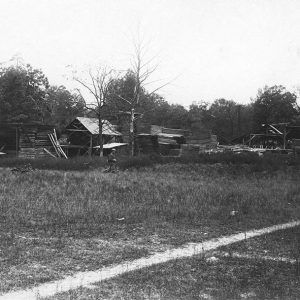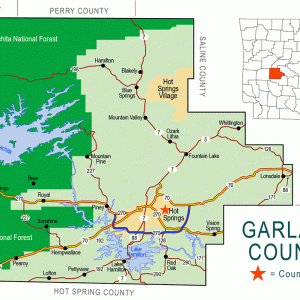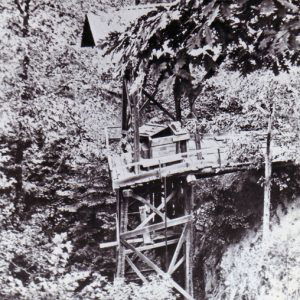calsfoundation@cals.org
Bear (Garland County)
Bear of Garland County was a boom town of the 1880s whose phenomenal growth was fueled by rumors that gold, silver, and other precious metals could be found in the nearby Ouachita Mountains. One enterprising fraud claimed to have found the legendary Lost Louisiana Mine. However, all such rumors ultimately proved false, and the town diminished as quickly as it had grown.
Before the gold rush, people had homesteaded in the area around Bear Mountain—the mountain from which the town later took its name. One early settler was Larkin Melson. The first post office was established in 1882. As early as 1884, rumors of gold in the area began to spread. That year, the first plat of Bear was filed. A telephone exchange was installed, and a drugstore and other businesses were soon founded in the boom town, necessitating an extension of the town’s limits. At one time, two different newspapers served Bear: Bear City Times and the Arkansas Mining Journal. By 1887, according to a list published in a Hot Springs (Garland County) newspaper, thirty-five different mining companies operated in Bear. Speculation was rampant. For example, the Garland County Silver Mining Co. alone issued more than 200,000 shares of its stock, which were valued at $5 million. By 1888, the town boasted five hotels, two sawmills, saloons, a Masonic lodge, and subscription schools. Estimates of the town’s population at its height range from 1,200 to 5,000.
Not everyone believed the unsubstantiated tales of gold and silver. Joseph Reynolds, who built the Diamond Jo Railroad from Malvern (Hot Spring County) to Hot Springs, offered to extend his railroad to Bear, provided that evidence of precious metals, in profitable abundance, could be produced. Rumors of gold helped motivate the state legislature to revive the Geological Survey of Arkansas (today the Arkansas Geological Survey) in order to investigate the various claims. John Casper Branner, state geologist, assigned Theodore B. Comstock to examine the mines at Bear and other such towns in the Ouachita Mountains. The survey soon published the first volume of the Annual Report of the Geological Survey of Arkansas for 1888, subtitled Report upon the Geology of Western Central Arkansas, with Especial Reference to Gold and Silver, which disputed the reported presence of precious metals in the region. Branner was reportedly hanged in effigy in Bear, but in the face of mounting evidence against mining companies’ claims, company stock was immediately made worthless, and the town fell apart.
A small community remained, however. A two-story schoolhouse was built in 1906. In 1930, Clarence B. Jewell opened a factory in Bear to mass-produce handmade, split-bottom, ladder-back chairs of the sort that had been made by the local Bump family starting in the late 1800s. The Works Progress Administration (WPA), a New Deal agency, later published positive accounts of the factory, which employed approximately twelve people at any given time. Two churches were also established in the 1930s. In the 1940s, the Bear school was consolidated with the Lake Hamilton School District in Pearcy (Garland County).
As time went by, the remnants of infrastructure built in the boom days began to interfere with local attempts to bring land into cultivation, and in the late 1960s and early 1970s, residents began to petition to have certain streets declared closed so that they could more conveniently open the land to farming. As of 2010, a few families remain in Bear, which is entirely surrounded by the Ouachita National Forest.
For additional information:
“Bear City Directory 1888.” The Record 17 (1976): 145–157.
Harington, Donald. Let Us Build a City: Eleven Lost Towns. San Diego: Harcourt Brace Jovanovich, 1986.
Hudgins, Mary D. “Gold and Silver Boom Town of Bear Thrived a Decade.” Arkansas Gazette. January 24, 1971, p. 4D.
Staff of the CALS Encyclopedia of Arkansas
 Bear Drugstore
Bear Drugstore  Bear Post Office
Bear Post Office  Bear Home and Hotel
Bear Home and Hotel  Bear Lumber Yard
Bear Lumber Yard  Garland County Map
Garland County Map  Jewell Lumber
Jewell Lumber  Lost Louisiana Mine
Lost Louisiana Mine  Bill Thompson
Bill Thompson 



My family lived in the Bear community when I was a young child, early 1960s. Late April to early May 1962, I fell into a 20-foot dug well and had to be rescued. The story was published in the Sentinel Record as well as other Arkansas newspapers. My name at the time was Brenda Carpenter.
I met Donna and Leon Sutton of the Bear Chair Shop in Royal, Arkansas. Leon is a sixth-generation relative of the Bump family of Bear, Arkansas, who have handcrafted Ouachita Mountain chairs since 1871. Grandpa Dallas Bump was 93 and working with nephew Leon to make the chairs while Donna, Leon’s wife mastered the art of weaving the backs and seats of the red oak chairs with split white oak strips.